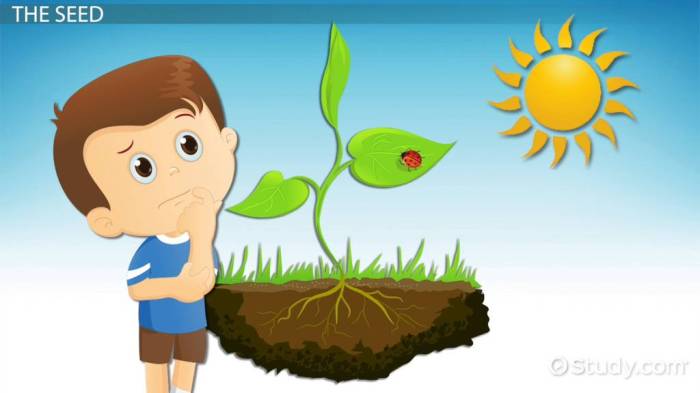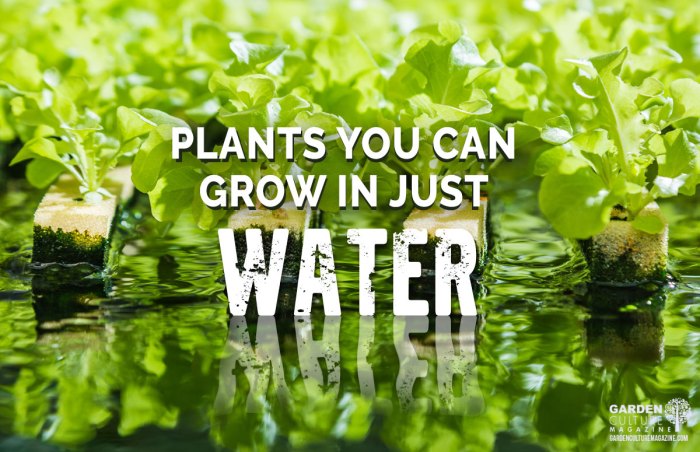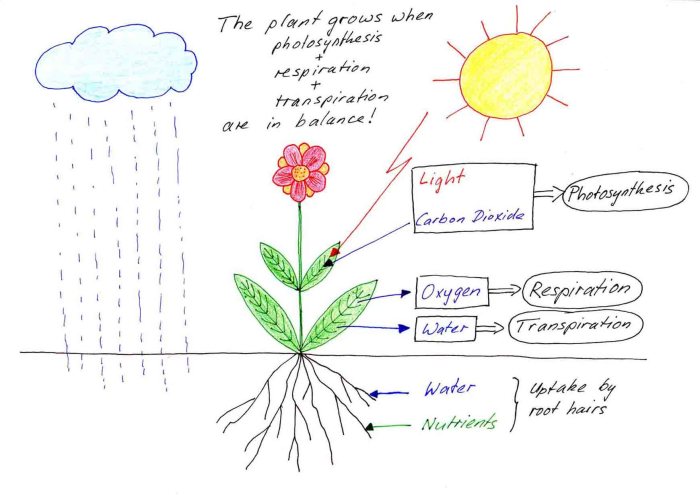How Does Water Help Plants Grow?
Water’s Crucial Role in Plant Growth: How Dose Water Help Plants Grow

Source: study.com
How dose water help plants grow – Water is fundamental to plant life, acting as both a structural component and a vital participant in essential physiological processes. Its role extends far beyond simply providing hydration; water is intimately involved in maintaining plant structure, facilitating photosynthesis, and transporting nutrients. Understanding water’s multifaceted influence is crucial to optimizing plant health and productivity.
Water Uptake and Plant Structure
Plants absorb water primarily through their roots via a process driven by osmosis and transpiration. Osmosis involves the movement of water across a semi-permeable membrane from an area of high water potential (soil) to an area of low water potential (root cells). This movement is driven by the concentration gradient of water molecules. Transpiration, the loss of water vapor from leaves, creates a negative pressure (tension) that pulls water upwards through the xylem, a specialized vascular tissue.
This continuous flow of water, known as the transpiration stream, is essential for maintaining cell turgor pressure.
Water contributes significantly to cell turgor pressure, the pressure exerted by the cell contents against the cell wall. This pressure is essential for maintaining cell shape, providing structural support to the plant, and enabling cell expansion, which is crucial for growth. A lack of water leads to wilting, as turgor pressure decreases, while excessive water (waterlogging) can deprive roots of oxygen, damaging cells and hindering growth.
Water deficiency leads to plasmolysis, where the cell membrane pulls away from the cell wall due to loss of turgor pressure. This causes wilting and ultimately cell death. Conversely, waterlogging restricts oxygen availability to roots, leading to anaerobic respiration and the accumulation of toxic byproducts, ultimately damaging root cells and impacting overall plant health.
| Plant Tissue | Function | Water Dependence | Impact of Water Stress |
|---|---|---|---|
| Xylem | Water and mineral transport | High | Reduced water transport, wilting |
| Phloem | Sugar transport | Moderate | Reduced sugar translocation, stunted growth |
| Parenchyma | Photosynthesis, storage | Moderate | Reduced photosynthesis, wilting |
| Collenchyma | Structural support | Moderate | Loss of structural integrity, wilting |
Water’s Role in Photosynthesis and Nutrient Transport

Source: hamanol.com
Water plays a crucial role in photosynthesis, the process by which plants convert light energy into chemical energy. In the light-dependent reactions, water molecules are split (photolysis) to provide electrons for the electron transport chain, releasing oxygen as a byproduct. This process is essential for energy production within the plant.
Water acts as a universal solvent, dissolving and transporting essential nutrients from the soil to various parts of the plant. These nutrients, absorbed by the roots, are carried in the xylem along with water to the leaves and other tissues. The movement of these nutrients is facilitated by the water’s solvent properties.
A diagram illustrating the path of water and nutrients would show water and minerals being absorbed by root hairs, traveling through the cortex and endodermis, entering the xylem vessels, moving upwards through the stem to the leaves via transpiration pull, and finally reaching the leaf cells for photosynthesis and other metabolic processes. Nutrients are transported in the phloem from source (e.g., leaves) to sink (e.g., roots, fruits) through pressure-flow mechanisms.
Vascular plants have specialized tissues (xylem and phloem) for efficient transport, while non-vascular plants rely on simpler mechanisms such as diffusion and osmosis for water and nutrient movement.
Water Requirements Across Plant Life Stages
Plants exhibit varying water requirements throughout their life cycle. Optimal water availability is crucial at each stage to ensure healthy growth and development. Insufficient or excessive water can negatively impact various growth phases.
- Germination: Requires sufficient moisture for seed imbibition and radicle emergence. Water stress can delay or prevent germination, while waterlogging can lead to seed rot.
- Vegetative Growth: Adequate water is essential for cell expansion and leaf development. Water deficiency results in stunted growth and reduced leaf area, whereas excessive water can lead to root rot.
- Flowering: Water availability influences flower initiation, development, and pollination. Water stress can reduce flower number and size, while excessive water can negatively affect pollen viability.
- Fruiting: Sufficient water is needed for fruit development and maturation. Water stress leads to smaller fruits with reduced quality, whereas waterlogging can cause fruit rot.
Water stress can manifest as stunted growth, reduced yield, and increased susceptibility to pests and diseases. Plants under water stress may exhibit wilting, leaf scorch, and premature leaf senescence.
Water Quality and Plant Health, How dose water help plants grow

Source: plant-and-flower-guide.com
The chemical composition of water significantly influences plant growth. Key factors include pH, mineral content, and salinity. Optimal pH levels ensure proper nutrient availability, while excessive salinity can inhibit nutrient uptake and damage plant tissues.
Different water sources (tap water, rainwater, well water) vary in their chemical composition. Tap water may contain chlorine and other chemicals that can affect plant health. Rainwater is generally considered ideal, while well water can vary significantly in mineral content and salinity. The suitability of each water source depends on the specific plant species and its tolerance to different chemical components.
| Parameter | Ideal Range | Impact of Deficiency | Impact of Excess |
|---|---|---|---|
| pH | 6.0 – 7.0 | Nutrient deficiencies | Nutrient toxicity |
| Nitrogen (N) | 1-2 ppm | Stunted growth, chlorosis | Excessive vegetative growth, reduced flowering |
| Phosphorus (P) | 0.5-1 ppm | Poor root development, delayed flowering | Nutrient toxicity |
| Potassium (K) | 1-2 ppm | Weak stems, reduced fruit production | Nutrient toxicity |
Water Conservation Adaptations in Plants and Agriculture
Plants in arid and semi-arid environments have evolved various adaptations to conserve water, including succulent leaves (e.g., cacti) to store water, deep root systems to access groundwater (e.g., mesquite trees), and reduced leaf surface area (e.g., desert shrubs) to minimize transpiration. Agricultural practices also play a crucial role in water conservation.
Drip irrigation, a method of delivering water directly to plant roots, minimizes water loss through evaporation. Mulching helps retain soil moisture by reducing evaporation and suppressing weed growth. Climate change poses significant challenges to plant water availability, leading to increased drought frequency and intensity. Strategies to mitigate these effects include developing drought-resistant crop varieties, improving water management practices, and promoting sustainable agricultural practices.
Plant hormones, such as abscisic acid (ABA), play a critical role in regulating water use and stress responses. ABA triggers stomatal closure, reducing water loss through transpiration, and promotes root growth to enhance water uptake.
FAQ Corner
Can I use tap water for my plants?
Tap water is often suitable, but check its chlorine and mineral content. High chlorine levels can harm plants, and excessive minerals may affect nutrient uptake. Rainwater is generally preferred.
How often should I water my plants?
Watering frequency depends on the plant species, pot size, soil type, and environmental conditions. Overwatering is as harmful as underwatering; check soil moisture before watering.
Why are my plant leaves wilting?
Wilting can indicate underwatering, overwatering, nutrient deficiencies, or pest infestations. Investigate the cause by checking soil moisture and examining the plant for signs of disease or pests.
What is the best time of day to water plants?
Early morning is generally recommended, allowing leaves to dry before nightfall, reducing fungal disease risk. Avoid watering during the hottest part of the day to minimize evaporation.




















